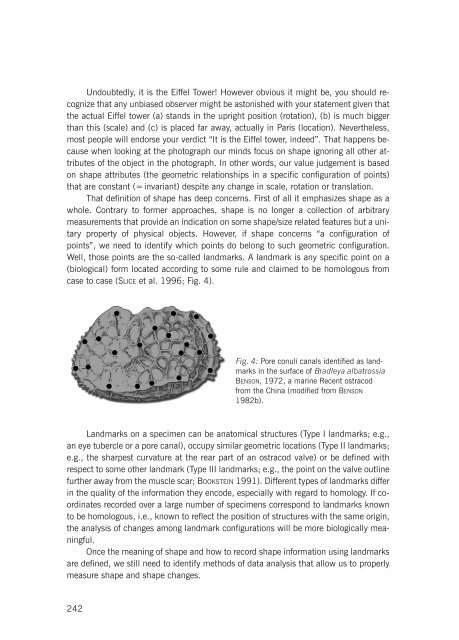Geo11_89_Baltanas_Danielopol_Geometric_Morphometrics
Geo11_89_Baltanas_Danielopol_Geometric_Morphometrics
Geo11_89_Baltanas_Danielopol_Geometric_Morphometrics
You also want an ePaper? Increase the reach of your titles
YUMPU automatically turns print PDFs into web optimized ePapers that Google loves.
Undoubtedly, it is the Eiffel Tower! However obvious it might be, you should recognize<br />
that any unbiased observer might be astonished with your statement given that<br />
the actual Eiffel tower (a) stands in the upright position (rotation), (b) is much bigger<br />
than this (scale) and (c) is placed far away, actually in Paris (location). Nevertheless,<br />
most people will endorse your verdict “It is the Eiffel tower, indeed”. That happens because<br />
when looking at the photograph our minds focus on shape ignoring all other attributes<br />
of the object in the photograph. In other words, our value judgement is based<br />
on shape attributes (the geometric relationships in a specific configuration of points)<br />
that are constant (= invariant) despite any change in scale, rotation or translation.<br />
That definition of shape has deep concerns. First of all it emphasizes shape as a<br />
whole. Contrary to former approaches, shape is no longer a collection of arbitrary<br />
measurements that provide an indication on some shape/size related features but a unitary<br />
property of physical objects. However, if shape concerns “a configuration of<br />
points”, we need to identify which points do belong to such geometric configuration.<br />
Well, those points are the so-called landmarks. A landmark is any specific point on a<br />
(biological) form located according to some rule and claimed to be homologous from<br />
case to case (SLICE et al. 1996; Fig. 4).<br />
242<br />
Fig. 4: Pore conuli canals identified as landmarks<br />
in the surface of Bradleya albatrossia<br />
BENSON, 1972, a marine Recent ostracod<br />
from the China (modified from BENSON<br />
1982b).<br />
Landmarks on a specimen can be anatomical structures (Type I landmarks; e.g.,<br />
an eye tubercle or a pore canal), occupy similar geometric locations (Type II landmarks;<br />
e.g., the sharpest curvature at the rear part of an ostracod valve) or be defined with<br />
respect to some other landmark (Type III landmarks; e.g., the point on the valve outline<br />
further away from the muscle scar; BOOKSTEIN 1991). Different types of landmarks differ<br />
in the quality of the information they encode, especially with regard to homology. If coordinates<br />
recorded over a large number of specimens correspond to landmarks known<br />
to be homologous, i.e., known to reflect the position of structures with the same origin,<br />
the analysis of changes among landmark configurations will be more biologically meaningful.<br />
Once the meaning of shape and how to record shape information using landmarks<br />
are defined, we still need to identify methods of data analysis that allow us to properly<br />
measure shape and shape changes.


